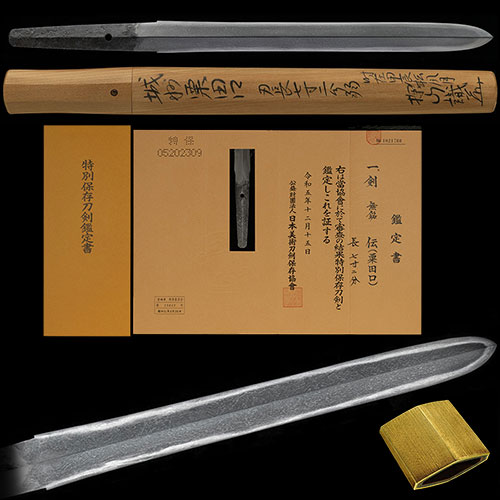
粟田口 剣Awataguchi Ken
No.044325剣 粟田口 鎌倉前期 国吉 気品ある剣の姿に食い違い二十刃金筋掛り地刃冴える格調高い名剣 七寸二分Ken Awataguchi Early Kamakura period Kuniyoshi graceful figure of a sword, Kuichigai, Nijuba, Kinsuji-kakari, Jiba is clear, A magnificent sword 21.8cm
- 極めKiwame
- 粟田口Awataguchi
- 登録証Registration
- 宮崎県 Miyazaki 昭和51年4月26日 4/26/51(Showa)
- 時代Period
- 鎌倉中期文永頃Mid-Kamakura period, around Bunei era
- 法量Size
-
刃長 21.8cm (七寸二分) 反り なし 元幅 2.0cm 元重 0.63cm 茎長 9.5cm 重量 125
Hachou 21.8cm (七寸二分) Sori なし Moto-Haba 2.0cm Moto-Kasane 0.63cm Nakago-Chou 9.5cm Weight 125
- 国Country
- 山城Yamashiro
- 姿Shape
- 両鎬造、身幅・寸法頃合い、先張らず上品な姿。Ryo-Shinogi-dukuri(double ridges), Mihaba and Sunpo Koroai(just the right size), An elegant appearance Sakiharazu.
- 鍛Kitae
- 小板目肌つみ、小杢目肌に、杢目交じり、地沸微塵に厚くつき、地景細かく入り、鉄冴える。Small-Itamehada-tsumi, Small-Mokumehada, Mixed Mokume, Jinie entered fine and thick, Chikei entered finely, Iron is clear.
- 刃文Hamon
- 直刃調に、浅くのたれて、小乱れ交じり、ほつれ・食い違い・二十刃掛り、小足入り、小沸深くよくつき、金筋・砂流し掛り、匂口明るく冴える。Suguha-style, Shallow Notare, Mixed small-Midare, Hotsure, Kuichigai, Nijuba-kakari, Small-Ashi entered, Small-Nie entered deeply well, Kinsuji and Sunagashi-kakari, Nioikuchi is bright and clear.
- 帽子Boushi
- 両側から焼きつめて小丸。Yakitsumetekomaru from both sides.
- 茎Nakago
- 生ぶ、先栗尻、鑢目勝手下り、目釘孔一。Ubu, Sakikurijiri, Yasurimekattesagari, Mekugiana is one(1)
- ハバキHabaki
- 金着一重。Single Kinkise.
- 説明Drscription
- 粟田口鍛冶は、国頼の子国家を祖とし、その子である国友・久国・国安・国清・有国・国綱の六人兄弟、国儔 の子則国。孫の国吉・国光、さらに国吉の子と伝える藤四郎吉光など、鎌倉時代初期から中期にかけ名工を輩出している。山城鍛冶の中でも、鍛えと匂口のよさに定評があり、品格高く技量が優れている。国吉には剣の遺例が比較的あり、年記作は弘長から弘安にかけて見られる。本作は、身幅・長さ頃合で、先張らず気品のある剣の姿を呈し、小板目肌に、杢目肌つみ、地沸が微塵に厚くつき、地景細かく入る所謂梨子地肌と呼称される明るく冴えた精妙なる地鉄に、直刃調に、のたれて、ほつれ・食い違い・二十刃掛り、小足よく入り、小沸深くよくつき、金筋砂流し掛り、匂口明るく冴える。粟田口沸と呼ばれる輝く細かな沸が明るく輝き、金筋が掛るなど刃中見事で、二十刃が掛るなど国吉の特色が表れた格調高い名剣である。The Awataguchi blacksmith was founded by Kuniyori's son Kuni, and his sons were six brothers: Kunitomo, Hisakuni, Kuniyasu, Kunikiyo, Arikuni, and Kunitsuna. Kuniyoshi and Kunimitsu, his grandsons, and Toshiro Yoshimitsu, who is said to be Kuniyoshi's son, produced master craftsmen from the early to the middle Kamakura period. Among Yamashiro blacksmiths, it has an established reputation for its forging and good smell, and is of high quality and excellent in skill. Hisakuni is the fourth of the Awataguchi Six Brothers, whose name is Shirobei, and is designated as an important cultural property, Juyo-Bijutsuhin. There are a relatively large number of surviving examples of swords in Kuniyoshi, and the annals of the period from the Kocho to the Koan period.
This sword has just the right size and Mihaba, and is elegant without being overhanging, Small-Itamehada, Mokumehada-tsumi, Jinie entered fine and thick, The blade is bright and clear, with fine chikei, so-called Nashijihada with clear beautiful Jigane. Suguha-style, Notare, Hotsure, Kuichigai, Nijuba-kakari, Small-Ashi entered well, Small-Nie entered deeply, Kinsuji and Sunagashi-kakari, Nioikuchi is bright and clear. The fine, shiny Nie called Awataguchi-Nie shines brightly, The blade is magnificent with its Kinsuji and Nijuba, which show the distinctive features of Kuniyoshi, making this a dignified sword.


